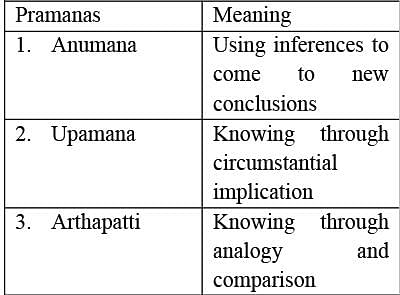Manipur PSC Prelims Paper 1 Mock Test - 9 - Manipur CSCCE MCQ
30 Questions MCQ Test - Manipur PSC Prelims Paper 1 Mock Test - 9
With reference to the special provisions made under article 371, consider the following matches:
- Article 371A - Nagaland
- Article 371B - Assam
- Article 371C - Manipur
- Article 371D - Mizoram
Which of the above matches is / are correct?
Consider the following:
1. Indica
2. Mahavamsa
3. Ritusamhara
4. Mudrarakshasa
How many of the above are the literary sources for the Mauryan empire?
| 1 Crore+ students have signed up on EduRev. Have you? Download the App |
With reference to the traditions of epistemology mentioned in the National Curriculum Framework of School Education (NCF-SE) 2023, consider the following pairs:

How many of the pairs given above are correctly matched?

How many of the pairs given above are correctly matched?
In the context of the development of education during British India, arrange the following education commissions/ committees in chronological order of their establishment.
1. Hunter Education Commission
2. Sadler University Commission
3. Hartog Committee
Select the correct answer using the code given below.
With reference to the poem “„Chchello Katoro Jerno Aa: Pi Jayo Bapu!‟ (Even this last cup of poison, you must drink, Bapu!), consider the following statements:
1. It was written by Zaverchand Kalidas Meghani.
2. The poem gave expression to the nationalist misgivings regarding the 2nd Round Table Conference.
Which of the statements given above is/are correct?
Consider the following:
1. Geological Hazards
2. Meteorological Hazards
3. Hydrological Hazards
4. Biological Hazards
5. Nuclear/Radiological hazards
How many of the above hazards can be mainly categorised as natural hazards?
Consider the following statements with reference to Vadnagar:
- The structural remains of ancient Buddhist monasteries and votive stupas have been found here.
- Vadnagar was strategically located where two major ancient trade routes crossed each other.
Which of the statements given above are incorrect?
Consider the following statements:
1. Biological weathering is the process of removal of minerals from the weathering environment due to the activities of microorganisms on decaying plants.
2. Anthropological activity can contribute to biological weathering.
Which of the statements given above are correct?
Which of the pair is correctly matched _________.
The language and ideals of the Preamble of Constitution of India is influenced / borrowed from which of the following constitution(s)?
1. USA
2. France
3. Australia
Select the correct option from the codes given below:
The constituent assembly was constituted under the scheme formulated by the Cabinet Mission Plan. Regarding the plan consider the following statements:
1. Allocation of seats for each province and princely state to be in proportion to their respective population
2. Representatives to be elected through proportional representation using a single transferable vote.
3. The representatives of the princely state were to be nominated by the heads of princely states.
4. Out of 296 seats allotted to British India, 292 members were to be drawn from the governor’s provinces and 4 from the chief commissioners’ provinces.
Which of the above statements is/are correct?
Consider the following statements regarding ‘Ways and Means’ advances:
- It is available for both Central and State governments.
- Government need to pay interest on ways and means advances.
- RBI Act, 1934stipulates that Government cannot borrow from RBI except by Ways and Means Advances (WMAs).
Which of the statement(s) above is/are correct?
Which of the following are the examples of Revenue Expenditure of Government?
- Salaries and pension of employees
- Grants given to state governments even if some of them may be used for the creation of capital assets
- Interest payment on loans taken by the government
- Repayment of loans
Select the correct answer using the code given below:
Which of the following items are included in the ‘non-Debt Capital Receipts’ of an economy?
- Recovery of loans and advances
- Issue of bonus shares
- Treasury bills
- State provident funds
- Disinvestment
Select the correct answer using the code given below:
With reference to the Biodiversity coldspots, consider the following statements:
1. They are the areas where the fitness of at least one of the two species is determined by interactions with the other.
2. Coldspots are relatively empty and have unstable environments.
3. They are better equipped to handle diversification of species than tropical areas.
How many of the above statements are correct?
The ‘Wright Brothers Moment’, sometimes appeared in the news, is in the context of:
‘Salton Sea’ which was recently in news is located in
Which of the following is not considered a source of modern Indian history?
Who was the Governor-General of India during the Revolt of 1857?
Which Indian king surrendered to Alexander without offering any resistance?
Whom did King Harshavardhana defeat to capture Kannauj, thus expanding his empire?
What role did the Varna system play in King Harshavardhana's society?
Sher Shah Suri's mausoleum is located in which town?
What was the zenana system in medieval India?

















